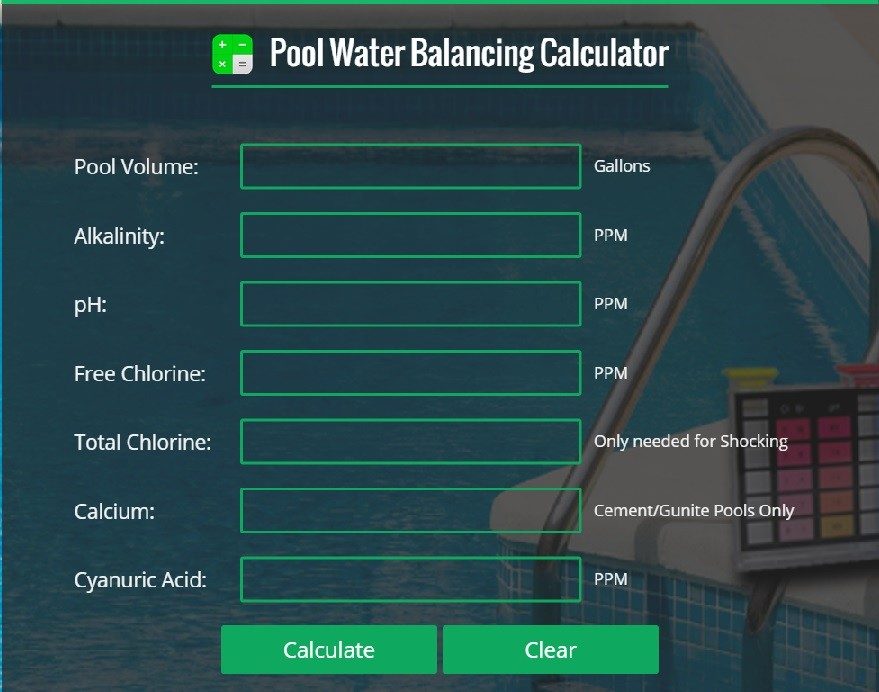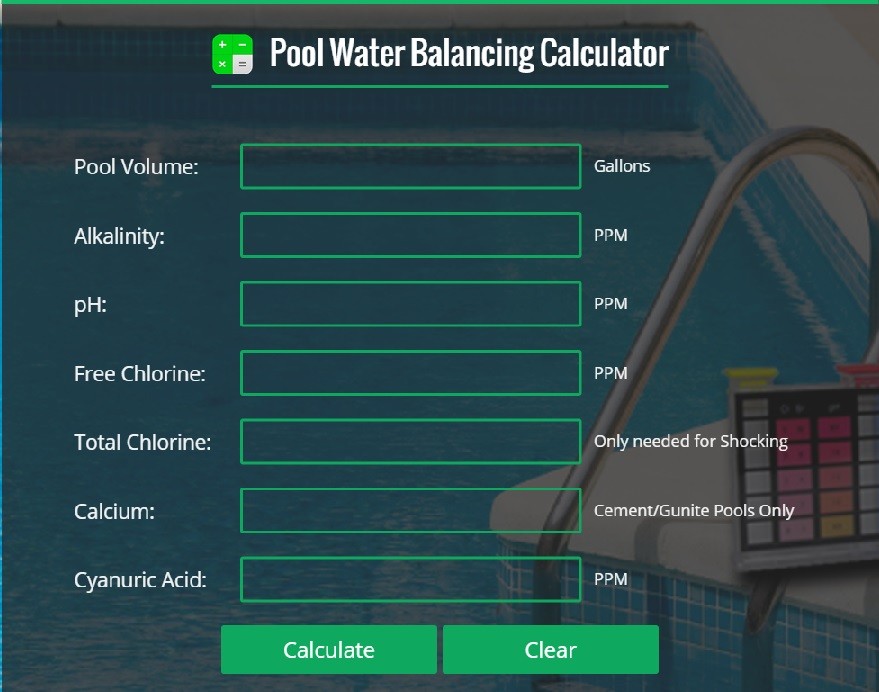Important SAFETY Rules To Follow When Balancing Pool Water
- RULE #1: Always read product label and follow instructions.
- RULE #2: Never mix chemicals (including different types of chlorine).
- RULE #3: Never add water to chemical, always add chemical to water.
This article is a user manual for our pool water balance calculator seen above. It will also teach you what you need to know about proper pool chemistry, and how to maintain a healthy pool. To use our live calculator please click the image above, or This Link.
The first thing you should know about our calculator is that it’s programmed for residential swimming pools only. Spas and commercial swimming pools require higher levels of chlorine.
The second thing you should know is it’s only as accurate as your pool volume entered (gallons), and other data you supply. It can not give you precise measurements unless it knows how many gallons are in your pool, or what your current chemical levels are. Pool Volume Chart
Testing Your Pool Water
You can not properly adjust your water chemistry unless you know where your at. So you need to test your water. There is a quick, simple, easy, and cheap way to test your water. I recommend Aquachek’s #7 Dipping Strips. You can buy them on Amazon for short money, you get 100 strips for like 15 bucks: AMAZON LINK.
You could always go to your local pool store with a water sample, but they are in the business of selling chemicals, name brand chemicals. With my calculator and Aquachek strips, you can balance your water, and know exactly what you need, and don’t need.
Pool Water Chemistry 101 – Balancing Your Pool Water With Our Calculator
I’m going to discuss each input field on our calculator, while providing acceptable and ideal ranges of each chemical as I go. I will share some insights about each chemical, while giving some practical advice. All without your eyes glazing over I hope :).
Pool Volume
Keep in mind that you may not know exactly how many gallons are in your pool. When adding chemicals to your pool, it wouldn’t hurt to make small adjustments, and then retest.
Without a close approximation of the amount of water in your pool. You will not be properly dosing your pool.
Alkalinity
When I open a pool, or service it for the first time, this is the first thing I adjust. Here in Massachusetts, pools with mesh pool covers tend to have very low alkalinity when opening them in the spring. Once you get alkalinity in range, check it once a month.
While NSPF water quality standards say that a range of 60-180 is acceptable for alkalinity, I have always tried to keep it between 80 and 120, with 100 being ideal.
Chemicals used to raise and or lower alkalinity: To raise alkalinity we use Sodium Bicarbonate. To lower alkalinity we use Sodium Bisulfate or Muratic Acid.
pH
7.2 – 7.8 is an acceptable range while 7.4-7.6 is ideal. We use sodium Carbonate / Soda ash to raise pH. We use Sodium Bisulfate or Muratic Acid to lower pH.
NOTE:
When using our calculator, you will not get a pH adjustment suggestion until your alkalinity is within range.
Chlorine / Free Chlorine
Chlorine is used to kill germs, algae, bacteria, and organisms like Cryptosporidium. Free Chlorine is the amount available in your water to kill these things. You always want to maintain a free Chlorine level of at least 1. Min Max Range being 1 to 5, with 2-4 being ideal.
There are many different types of Chlorine, with different strengths. Some are liquids, like Sodium Hypochlorite, Some are powders, like Trichlor, Dichlor, and Calcium Hypochlorite. NEVER MIX TYPES. If you pour liquid over solid it could go boom.
If you have a vinyl liner, you may use liquid Chlorine as I recommend, but you may also keep a couple Chlorine tabs/pucks in a floater, or in the skimmer basket. Do not pour liquid chlorine near the skimmer, or floater, with tabs/pucks in either.
The calculator gives you a choice of these four chlorine types. So no matter which type of Chlorine you have, you know how much to use.
Total Chlorine – Shocking Pool / Breakpoint SuperChlorination
As Chlorine works killing unwanted germs, sweat, suntan lotions, and what have you. It creates dangerous levels of something called Chloramines / Combined Chlorine. We shock our pools to kill Chloramines.
Few understand the importance of properly shocking a pool. Most people think shock is a special chemical called shock. They think you just dump in an arbitrary amount each week and your all set. NOTE: You use Chlorine to shock a pool.
To figure out if you need to shock your pool, or in order to properly shock a pool / reach Breakpoint Superchlorination. You have to first figure out the level of Chloramines. This is done for you by using our calculator.
Using Our Calculator: You just input your free Chlorine and Total Chlorine levels, along with gallons of water in your pool, and the calculator will tell you if your pool needs shocking. If it needs shocking, the calculator will specify the amount of Chlorine necessary to do the job properly. 🙂 Or you could learn this formula:
Shocking / Breakpoint Superchlorination FORMULA: Total Chlorine subtract Free Chlorine equals Combined Chlorine / Chloramines. Combined Chlorine multiplied by 10 equals the level of free chlorine necessary to kill Chloramines. We then subtract our existing free Chlorine from necessary level to calculate total adjustment. Once we know how high we need to raise the Chlorine level to neutralize Chloramines, we do a little more math to figure out how much is necessary to treat the amount of water in your pool.
Calcium
If you have a cement, gunite or plaster pool, then you will want to keep a close eye on Calcium / Hardness. Keeping it between 150 and 1000, with the ideal range being between 200 and 400.
If your pool has a vinyl liner, you don’t need to pay as close attention. Probably only need to adjust it once a year.
You can raise Calcium level with Calcium Chloride, but the only way to lower it is with water replacement.
Cyanuric Acid / CYA
CYA is a Chlorine stabilizer. Many people pay this no mind, but with the high cost of Chlorine, you would be wise to monitor this chemical. Minimum level is 0 and high level is 100, with the ideal range being between 30 and 50.
Dichlor and Trichlor erosion tablets contain CYA, if CYA levels creep up, you may want to switch to a Calcium Hyperchlorite. The only way to reduce CYA is with water replacement.
It should be noted that the higher the CYA levels, the less effective your Chlorine sanitizer is.
Commonly Accepted Swimming Pool Chemical Range Chart
| Chemical | MIN | IDEAL | MAX |
|---|---|---|---|
| Free Chlorine | 1.0 | 2.0 – 4.0 | 5.0 |
| Combined Chlorine | 0 | 0 | 0.2 |
| Alkalinity | 60 | 80 – 120 | 180 |
| pH | 7.2 | 7.4 – 7.6 | 7.8 |
| Calcium | 150 | 200 – 400 | 1000 |
| Cyanuric Acid | 0 | 30 – 50 | 100 |

